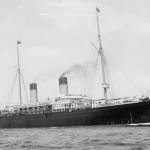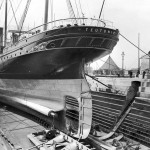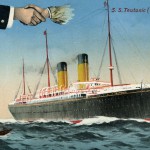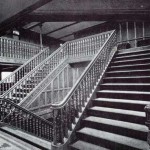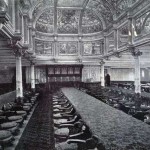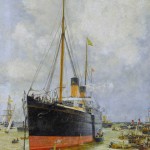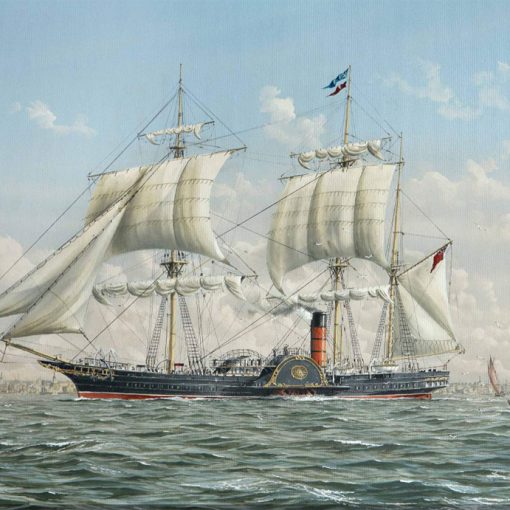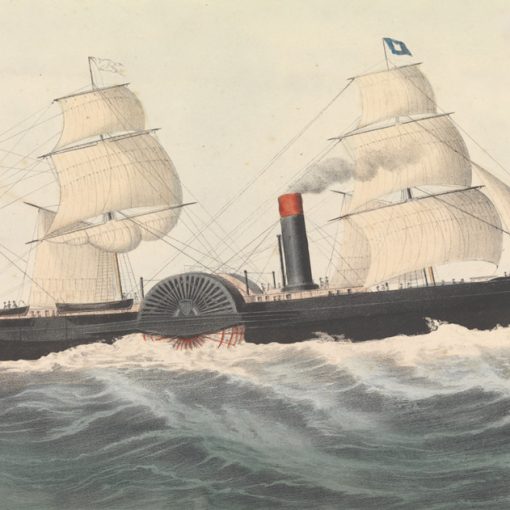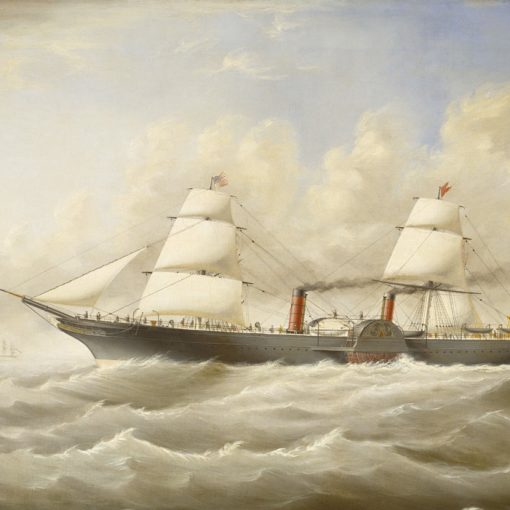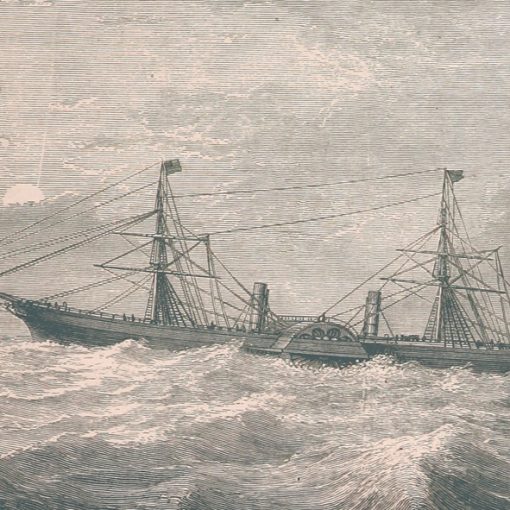1889 – 1921
At the end of the 1880s, the Great Eastern was still the largest ship in the world, even though she had been scrapped in 1888. The fastest ship, the one that held the Blue Riband was Cunard’s Etruria with an average Atlantic-crossing speed of 19.56 knots. In 1889 the title was given to the Inman and International Line’s City of Paris, who managed 20.01 for the same distance. Since the White Star Line, with Thomas Henry Ismay as managing director, still was interested in having the fastest ship on the North Atlantic, the company commissioned two new ships from Harland and Wolff’s shipyard. These two ships would manage to maintain a service speed of somewhere over 20 knots, and that should make them able to get the Blue Riband.
The first of this duo was decided to be named Teutonic. The ship would have two triple expansion engines that would turn one propeller each. The Teutonic’s keel was laid in March 1887, and the design drawings, that had been shown to the Admiralty, were by them approved to be the finest ship-design ever drawn. The chief designer, Alexander Montgomery Carlisle would prove his skills many times in the future as well; for instance, he was the man that designed the Olympic-class exteriors twenty years later. The Teutonic was the first ship with no rigged sails, and that was because of the great power in her twin screws. The White Star Line had left sails behind, and would stand as an example for many other ship companies forevermore.
On January 19, 1889, the Teutonic was launched. The vessel was built under the Auxiliary Armed Cruiser Agreement, and therefore after being completed on July 25, she left Liverpool to the Spithead Naval Review on August 1, to mark Queen Victoria’s 50 years on the throne as the first Armed Merchant Cruiser. On August 3, the Teutonic was inspected by the Prince of Wales and the German Kaiser Wilhelm II. It is said that when the German sovereign saw the Teutonic he uttered ‘We must have some of these’. That was the first thoughts of the German express liners Kaiser Wilhelm der Grosse with siblings. Later, she was disarmed in order to enter commercial service.
Teutonic went through her maiden voyage between Liverpool and New York on August 7, the same year, replacing the old Baltic from 1871, but she was not able to snatch the Blue Riband from the City of Paris. The ship that took the honour from City of Paris was Teutonic’s own sister, Majestic, who had had her maiden voyage in 1890. This proved what the sisters were capable of, and in 1891, the Teutonic made an even faster voyage and received the Blue Riband with an average speed of 20.25 knots. She bettered this record later with an average speed of 20.5 knots.
In 1897, the old Queen Victoria had sat on the British throne for 60 years, and as part of the celebrations, the Teutonic honoured the queen with yet another naval review as an Armed Merchant Cruiser. During the festivities, Charles Parson showed his turbine-wonder Turbinia, a yacht that was able to sail at 32 knots. Thomas Ismay, among others, was invited to a trial run at forty miles an hour, which he gladly accepted.
The Teutonic’s first mishap occurred in 1898 in New York harbour, when she collided with the United States’ transporter Berlin. None of the ships suffered severe damage though, and soon the Teutonic – and the Berlin – was back in service. During the winter of 1900, the Teutonic was used in the Boer conflict as a troop transport . She certainly showed her worthiness, and returned from the war unscathed.
In February 1901, the Teutonic was swamped by one of the horrors of ship-captains; a massive earthquake tsunami. Fortunately, this happened during the night-hours, and no passengers were harmed by the deadly rush of water. However, the two men situated in the crow’s nest was thrown down onto the deck, but survived.
In 1907, the White Star Line changed their main route from Liverpool-New York to Southampton-New York. The Teutonic was scheduled to enter the new ‘way’, and on June 12, she made her first crossing between the two cities. Four years later, the Teutonic was extensively rebuilt to fit with the new standards of the ship-world. In 1913, she had become that old that White Star decided to make the steamer into a two-class ship. No distinguished passenger seemed to choose the Teutonic any longer. Just one year after she had won the Blue Riband she had lost it to City of Paris, so the ship was not the fastest, and certainly not among the largest anymore. From 1913 and since she only carried second and third class passengers.
In 1914, when the Teutonic was 25 years old, the First World War began. Since all merchant vessels were desperately needed, she was commissioned as an Armed Merchant Cruiser in the 10th Cruiser Squadron along with her fleet mates Celtic and Cedric, among others. The Teutonic had hurriedly been asked for to replace Cunard’s Aquitania who had been damaged in a collision with the Leyland Line’s Canadian. The Teutonic served the British Empire until 1916, when she was held as a reserve ship, because there was enough adequate vessels in Admiralty service. The last effort the Teutonic would do during the hostilities was to sail between Great Britain and Alexandria as a troop transporter with place for 1,500 soldiers. Even though under Admiralty laws, the ship was managed by the White Star Line during this last year of the war.
Just a few years after the war had ended the Teutonic was laid up in Cowes Roads in 1921. The Majestic had been scrapped in 1914, before the war, thus the Teutonic outlived her sister. She had served in war, in peace, she had inspired the German Kaiser to build new ships, and last but not least, she had held the Blue Riband of the Atlantic. She and her sister Majestic was the last of the White Star Line’s vessels to ever have that honour. Being 32 years old, no one expected the Teutonic to continue after she had been laid up, and later the same year she was broken up where she lay.
Specifications
- 582 feet (177.7 m) long
- 57.7 feet (17.6 m) wide
- 9,984 gross tons
- Two triple expansion engines powering two propellers
- 20 knot service speed
- Passenger capacity of 1,490 people

